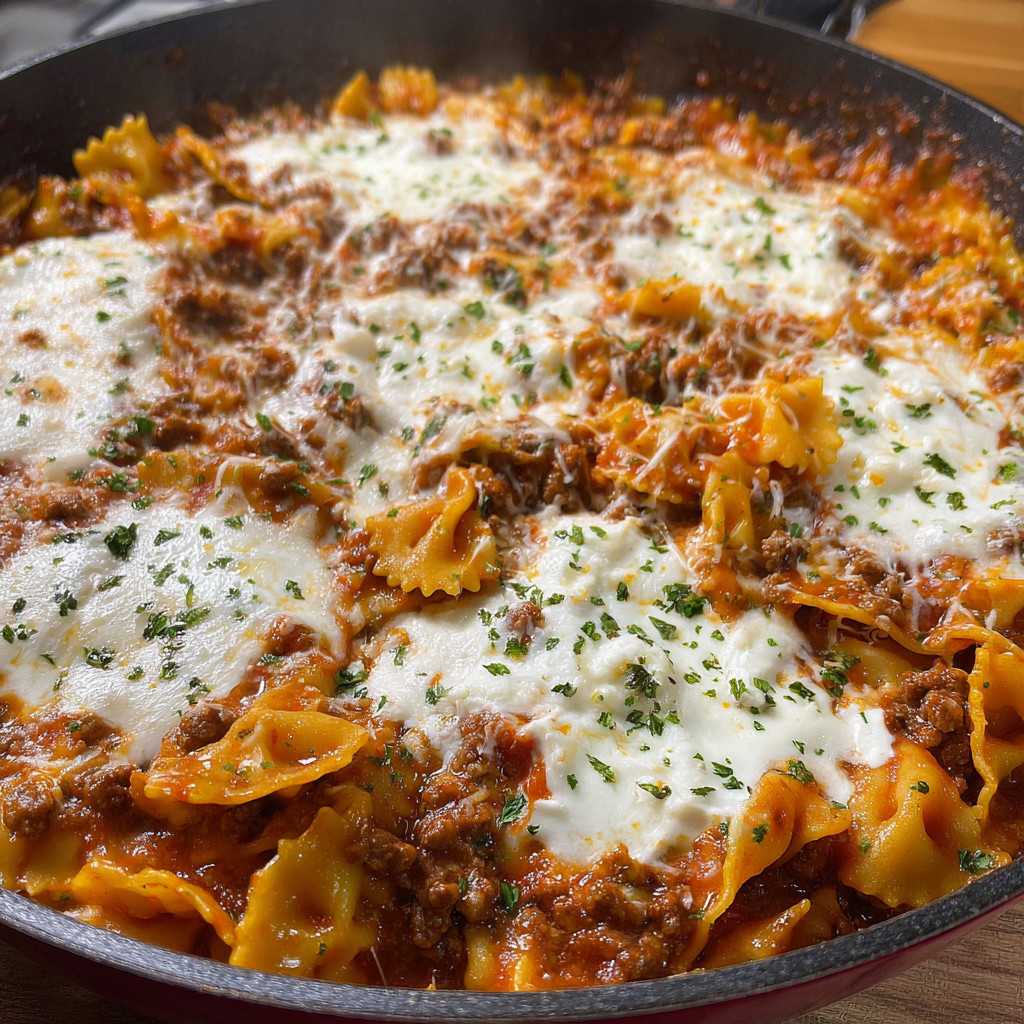 Save
Save
This One-Pot Skillet Lasagna captures all the comforting flavors of traditional lasagna while cutting down on effort and cleanup. With layers of ground beef, Italian sausage, hearty tomato sauce, and a luscious mix of cheeses, this dish comes together in one skillet, making it perfect for busy weeknights or casual dinners.
Ingredients
- Ground beef: choose lean for a balance of flavor and less grease
- Yellow onion: adds sweetness and depth when sautéed
- Onion powder: enhances the overall savory profile
- Garlic powder: boosts the aromatic quality without overpowering
- Italian seasoning: brings traditional herb notes essential to lasagna
- Salt and black pepper: fundamental for seasoning and bringing flavors together
- Pasta sauce: select a quality marinara for robust tomato flavor
- Chicken broth: helps soften the noodles and adds subtle richness
- Lasagna sheets: broken into smaller pieces for even cooking in the skillet
- Parmesan cheese: sharp and nutty, key for depth in the cheese mixture
- Mozzarella cheese: provides gooey meltiness on top and within
- Ricotta cheese: creamy base for cheesy layers adding richness
How To Make One-Pan Skillet Lasagna
- Sauté the Meat and Onions:
- In a large deep skillet over medium-high heat, add the lean ground beef and diced yellow onion. Cook them until the meat is fully browned with no pink remaining. Drain any excess grease to prevent a greasy sauce, then return the meat to the pan. Season with onion powder, garlic powder, Italian seasoning, salt, and black pepper to build the flavor foundation.
- Add Sauce and Broth:
- Stir in the pasta sauce and chicken broth making sure the mixture is well combined. The broth will help the noodles cook properly and keep the sauce from becoming too thick.
- Incorporate Pasta Sheets:
- Break the lasagna sheets into smaller manageable pieces and add them evenly across the skillet. Stir gently to coat the pasta well with the sauce and meat mixture. Cover the skillet and bring it to a simmer. Let it cook for 10 to 15 minutes, allowing the pasta to soften and become al dente. Keep an eye on the liquid levels and add more water by 1/2 cup increments if the pasta looks dry or the sauce is evaporating too fast.
- Prepare and Add Cheese Layer:
- In a medium bowl, mix together ricotta cheese, half a cup of Parmesan, and half a cup of mozzarella cheese until smooth. Drop small spoonfuls of this cheese mixture evenly over the partially cooked pasta. Then sprinkle an additional half cup each of parmesan and mozzarella cheese on top.
- Bake Until Golden:
- Place the skillet in a preheated oven at 350 degrees. Bake for 10 to 15 minutes or until the cheese melts completely and forms a bubbly golden crust on top.
- Serve and Enjoy:
- Scoop portions onto plates and enjoy the delicious layers of gooey cheese, tender pasta, and savory meat sauce from this one-pan wonder.
 Save
Save
Storage Tips
Allow the lasagna to cool completely before covering to avoid condensation which can make it watery. Store leftovers in an airtight container to preserve freshness and flavor. Refrigerate for up to three or four days. For freezing, portion the lasagna into meal-sized containers and freeze for up to two months. Reheat gently in the oven or microwave until warmed through.
Ingredient Substitutions
You can swap ground beef with ground turkey to reduce fat and calories or add Italian sausage for extra spice and complexity. Cottage cheese can replace ricotta for a lighter texture. Use gluten-free lasagna sheets if needed to accommodate dietary restrictions. Vegetables like spinach, mushrooms, or zucchini can be added when cooking the meat to boost nutrition and flavor.
Serving Suggestions
Pair this skillet lasagna with a fresh arugula or mixed greens salad dressed with a simple vinaigrette. Garlic bread or crusty Italian bread make great accompaniments to soak up the sauce. A side of roasted vegetables or steamed broccoli complements the richness of the cheese and meat perfectly.
Pro Tips
Use a large deep skillet or saute pan to give noodles room to cook evenly and absorb the sauce. Remember to monitor liquid levels closely while simmering the pasta — add water gradually if needed to keep everything moist but not soupy. Resist the urge to overcook pasta by tasting early and often aiming for al dente texture so the noodles hold up well after baking.
Common Recipe Questions
- → How do I ensure the noodles cook evenly?
Keep the noodles submerged in the sauce and broth mixture while simmering. If the liquid starts drying, add water in small amounts to maintain a steady simmer until noodles are tender but firm.
- → What indicates the dish is fully cooked?
The cheese topping should be melted and golden brown, and the pasta will be cooked through to a tender, slightly firm al dente texture when stirred.
- → Can vegetables be added to enhance flavor?
Yes, chopped vegetables like spinach, mushrooms, or zucchini can be added with the meat to boost both nutrition and taste without affecting the cooking process.
- → Is it possible to substitute the meat used?
Ground turkey can replace ground beef for a lighter dish, or keep the Italian sausage for a richer flavor depending on preference.
- → What skillet type is best for cooking?
Use a deep, large skillet or a high-sided sauté pan to allow the noodles space to cook evenly while soaking in the sauce.
